View the above photo record (by Gregg Darling) in OdonataMAP here.
Find the Southern Fingertail in the FBIS database (Freshwater Biodiversity Information System) here.
Family Gomphidae
Gomphidia quarrei – SOUTHERN FINGERTAIL
Identification
Large size
Length up to 61mm; Wingspan reaches 75mm.
A striking and boldly marked species.
Most resembles Ictinogomphus ferox but Gomphidia quarrei is noticeably smaller and more slender. Additionally the Southern Fingertail lacks foliations on the terminal segments of the abdomen.
Females closely resemble the males but have more robust abdomens.
Click here for more details on identification of the Southern Fingertail.
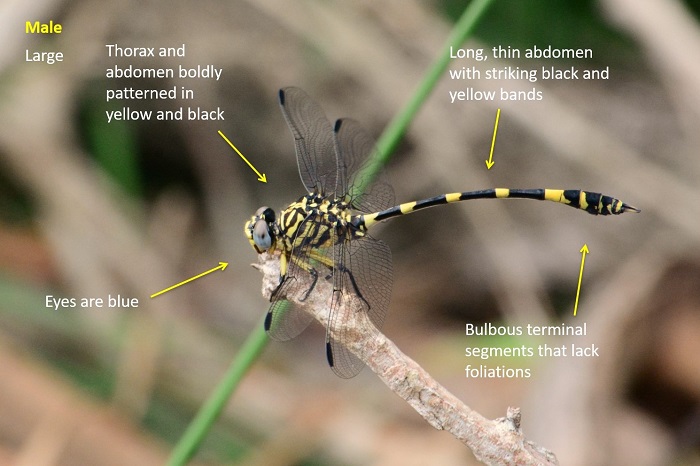
Kosi Bay, KwaZulu-Natal
Photo by Ryan Tippett
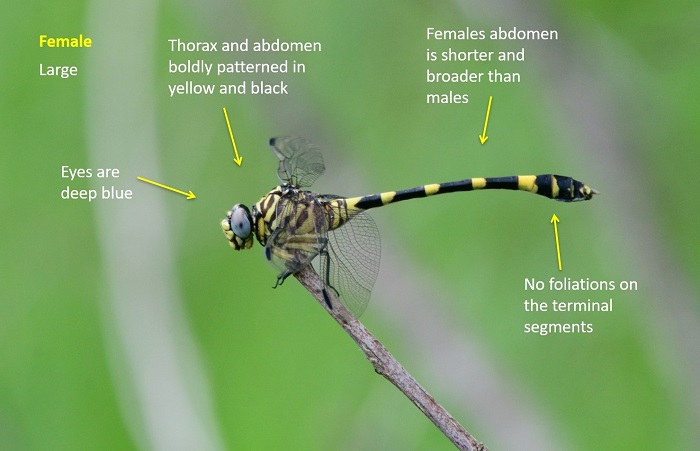
Kosi Bay, KwaZulu-Natal
Photo by Ryan Tippett
Habitat
Frequents rivers and streams in hot savanna or forest regions. They require reed-lined and/or wooded banks for perching on. They are not reliant on rocky stretches of river and appear to like shallow, flowing water over sand. Non-breeding individuals can often be found in grassy clearings within a hundred or so meters of the river.

Photo by Ryan Tippett
Behaviour
This species is a perch hunter. They return to their perch after each foray to chase down prey or a potential rival. The flight is swift and agile. Territorial males often perch low down on vegetation overhanging the water. At other times and especially during the heat of the day they can be found away from the water on trees and bushes above the riverbank. Females and non-breeding males are found further from the river.
Most active from November to February (see Phenology below)
Status and Conservation
An uncommon and localised species. Its presence, even at known sites, is erratic. Due to its marginal occurence within South Africa, Gomphidia quarrei is listed as Vulnerable in the IUCN Red List of Threatened Species. It is listed globally as of Least Concern as it has a wide distribution within the rest of Africa. It is sensitive to habitat degradation and, for the most part, occurs only in undisturbed habitats.
Distribution
Gomphidia quarrei is widely distributed over much of Central and East Africa. It’s range extends into South Africa where it is restricted to the warmer northern and eastern regions.
Below is a map showing the distribution of records for the Southern Fingertail. Taken from the OdonataMAP database as at February 2020.

The next map below is an imputed map, produced by an interpolation algorithm, which attempts to generate a full distribution map from the partial information in the map above. This map will be improved by the submission of records to the OdonataMAP section of the Virtual Museum.
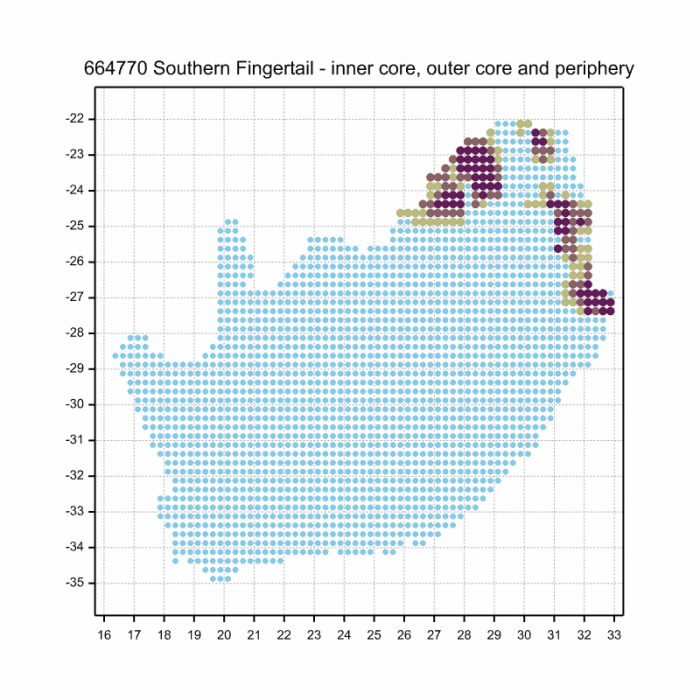

Ultimately, we will produce a series of maps for all the odonata species in the region. The current algorithm is a new algorithm. The objective is mainly to produce “smoothed” maps that could go into a field guide for odonata. This basic version of the algorithm (as mapped above) does not make use of “explanatory variables” (e.g. altitude, terrain roughness, presence of freshwater — we will be producing maps that take these variables into account soon). Currently, it only makes use of the OdonataMAP records for the species being mapped, as well as all the other records of all other species. The basic maps are “optimistic” and will generally show ranges to be larger than what they probably are.
These maps use the data in the OdonataMAP section of the Virtual Museum, and also the database assembled by the previous JRS funded project, which was led by Professor Michael Samways and Dr KD Dijkstra.
Phenology
The next two graphs shows how the occurrence of Southern Fingertail varies within the year, i.e. the phenology. There are 50 records in the database for this species, so these results are still likely to change as the same size increases. The first plot shows the number of records in each pentade, five-day periods, which start on 1 July and end on 30 June the following year. The maximum number of records is at the beginning of December, with 12 records. The blue line is generated by a smoother, an algorithm which aims to separate the “signal” from the “noise”, and shows the pattern of seasonality for this species. The second plot shows only the blue line, and it is scaled to lie between zero and one, for easy comparison between species.
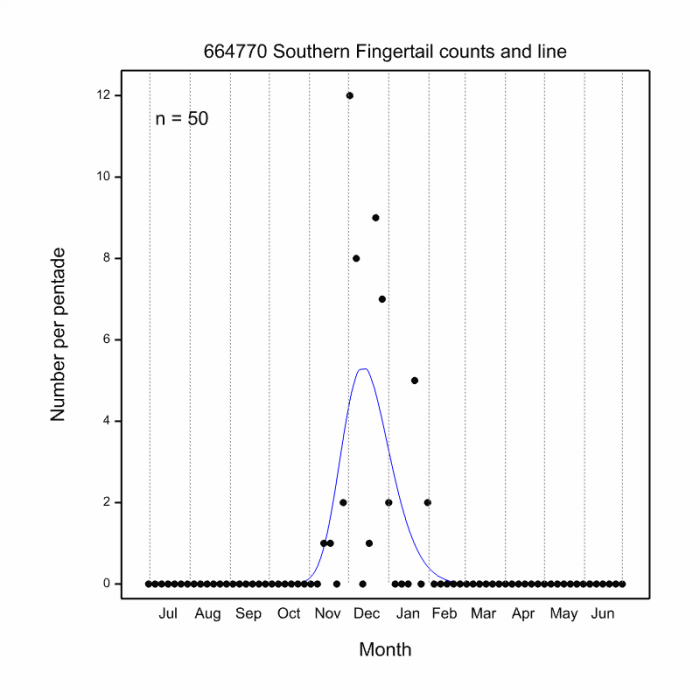
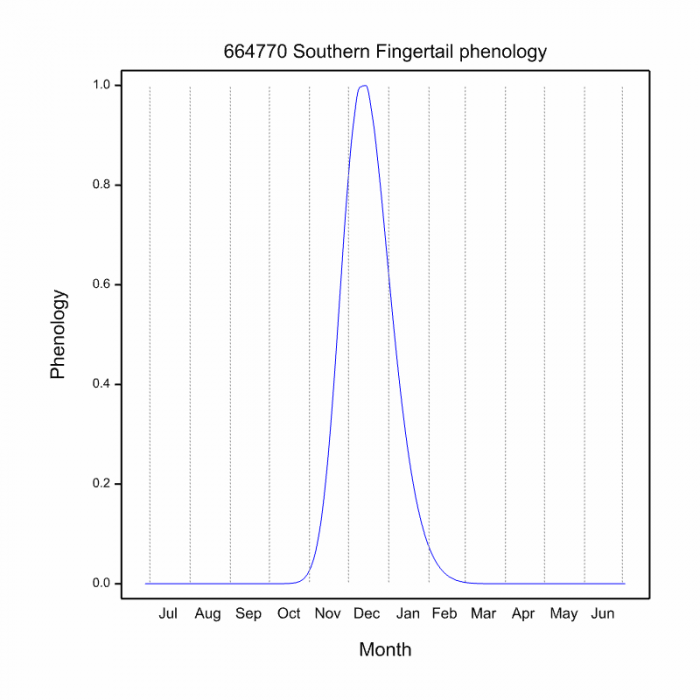
This phenology plot shows that the Southern Fingertail has a short flight period, lasting about three months, from November through to January, with a December peak.
We are needing lots more records of Southern Fingertails in OdonataMAP to help confirm the seasonality of this species. If you live anywhere within its large range, please be alert from October to February, and submit records to OdonataMAP. The number of records throughout the flight period, even during the December peak, needs to be increased.

